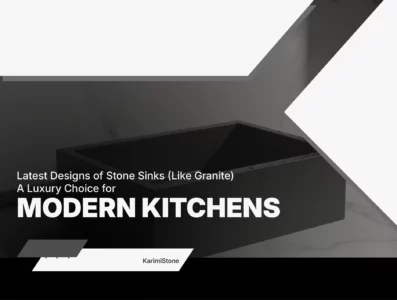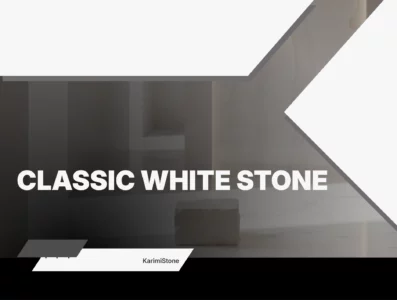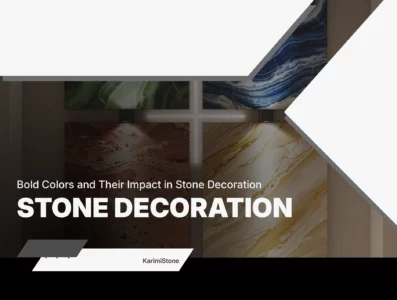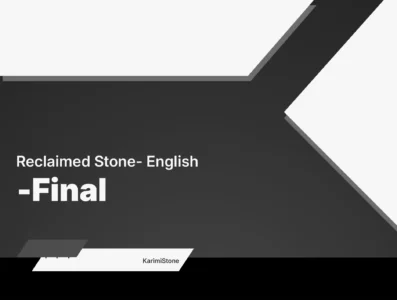
Post Page
Comparing the Durability and Strength of Travertine and Marble

Abstract
Travertine and marble are carbonate stones widely used in architecture and decorative building finishes. Both are predominantly calcium carbonate (calcite ± aragonite or dolomite) but differ in origin and internal fabric: travertine is a chemical/biochemical precipitate (often banded and porous), while marble is a recrystallized metamorphosed carbonate (generally crystalline and more compact). These differences produce distinct mechanical behaviours and durability performance: porosity and pore morphology strongly control compressive and flexural strength, water uptake, salt susceptibility and freeze/thaw sensitivity. This article synthesizes mineralogical, physical, mechanical and durability data from scientific studies and standards to give practical, evidence-supported guidance for material selection, processing, and specification.
Mineralogy and genesis (why these stones differ at the micro scale)
Travertine: Travertine is a variety of carbonate rock that forms by rapid precipitation of calcium carbonate from supersaturated waters (mineral springs, hot springs, rivers). Its mineralogy is dominated by calcite and commonly aragonite; the depositional mechanism produces a banded texture and a characteristic network of primary voids (cavities and vesicles) and secondary pores filled or partly filled by later cement or impurities. These pore networks give travertine a relatively high and variable porosity compared with many compact carbonates.
Marble: Marble is a metamorphic carbonate rock formed by recrystallization of limestone or dolostone under heat and pressure. The recrystallization produces an interlocking mosaic of equigranular calcite (or dolomite) crystals, typically with much lower primary porosity and a crystalline texture that yields different anisotropic mechanical properties depending on grain size, dolomite content, and presence of secondary minerals (mica, silicates, oxides).
Practical implication: microfabric (pore connectivity, grain contacts) rather than just bulk composition controls mechanical strength, water transport and weathering pathways.
| Property | Travertine | Marble |
| Origin | Rapid precipitation of calcium carbonate from supersaturated waters | Metamorphism of limestone or dolomite under pressure and heat |
| Composition | Calcite ± aragonite | Calcite or dolomite ± accessory minerals |
| Texture | Layered, with primary and secondary pores | Mosaic, interlocking crystals |
| Porosity | High and variable | Very low |
Key physical properties that control durability
Below are the properties most relevant to a stone-processing factory and to architects/engineers.
Density & specific gravity: Marble (recrystallized calcite/dolomite) commonly has higher bulk densities and specific gravity when compared with porous travertine of similar composition. Density correlates inversely with open porosity and usually predicts higher compressive strength (Mao et al (2023), Erdogan (2011)).
Open porosity & water absorption. Travertine typically shows higher porosity and water absorption (often single-digit to >10% by volume depending on facies and filling), while marbles commonly show very low porosities (often <1% to a few percent for high quality marbles). Porosity controls capillary water uptake, salt transport and the stone’s sensitivity to freeze–thaw and salt crystallization (Zhang et al (2023), Huillca et al, (2023)).
Abrasion resistance & surface hardness. Both stones are relatively soft (calcite Mohs ≈ 3), but bulk abrasion resistance depends on porosity, grain contacts and any harder inclusions. Dense marbles often show higher abrasion resistance in laboratory panels than highly porous travertines. However, some well-cemented travertines can perform very well for pedestrian surfaces if properly finished and sealed (Erdogan (2011)).
| Property | Travertine | Marble |
| Density | Lower in porous types | Higher, especially in dolomitic ones |
| Porosity | 8–15% (Huillca et al, 2023) | Less than 1% to a few percent |
| Water Absorption | High (dependent on filling) | Very low |
| Hardness (Mohs) | 3 | 3 |
| Abrasion Resistance | Dependent on filling and finishing | Generally higher in dense types |
Mechanical properties (strength, stiffness, and variability)
Uniaxial compressive strength (UCS)
Marble: UCS values reported in the literature vary widely with provenance and microstructure, but dense marbles often show UCS in the range of tens to a few hundreds of MPa (typical engineering marbles commonly tens to ~200 MPa depending on testing and anisotropy). Recent studies show that UCS for marbles can be correlated with nondestructive rebound (Schmidt) or P-wave velocity tests for quality control (Yavuz&Topal, (2006), Erdogan (2011)).
Travertine: UCS is strongly controlled by porosity and laminae orientation; many travertines exhibit lower UCS than dense marbles, though compact facies of travertine (low-open-porosity bands) can reach moderate UCS values suitable for many structural and finish applications (reported ranges in the literature vary widely (from low tens to similar ranges as weaker marbles in some cases). Recent predictive studies emphasize porosity as the dominant control on UCS for travertine (Mao et al (2023), Yavuz&Topal, (2006)).
Flexural (modulus of rupture) and modulus of elasticity
Both stones show reductions in flexural strength and Young’s modulus when porosity increases or when microcracks/laminations are present. For marble, freeze/thaw or chemical weathering can reduce Young’s modulus significantly (reported lab studies show reductions after many cycles). Travertine’s anisotropic laminae and macro-voids cause more complex bending behaviour and lower rupture values in many facies (Erdogan (2011), Huillca et al, (2023)).
Variability is the rule
Both natural stones have large within-quarry and within-block variability. This is a critical manufacturing consideration: strength and serviceability must be specified by tested lot(s) and not assumed from generic labels. ASTM test methods provide standard procedures to quantify these properties for specification.
Environmental resistance: freeze–thaw, salt crystallization, acids, thermal cycling
Freeze/thaw sensitivity: Stones with higher open porosity and connected pore networks are more vulnerable to freeze–thaw damage because water within pores expands on freezing or generates hydraulic pressures during rapid temperature changes. Experimental work shows marble’s Young’s modulus and strength can decline markedly after repeated freeze/thaw cycles; travertine, depending on facies, may be even more vulnerable if pore sizes and connectivity favour ice growth stresses. However, dense marbles with very low porosity can resist many cycles (Zhang et al (2023)).
Salt crystallization and chemical weathering: Carbonate stones are susceptible to salt-induced damage (crystallization pressure) and chemical dissolution in acidic environments. Travertine’s open voids can act as reservoirs for salt accumulation and crystallization, accelerating decay in polluted or marine-exposed settings. Marble, while crystalline and often denser, still undergoes surface scaling and grain loss if salts concentrate near the surface; acid rain and sulfurous environments accelerate marble dissolution because calcite is acid-soluble (Erdogan (2011), Huillca et al, (2023)).
Thermal stability: Both calcitic travertine and calcitic marble are thermally reflective materials with limited high-temperature stability (calcite decomposes at high temperatures > 600–800 °C). For normal building temperature ranges they are stable, but thermal cycling combined with moisture can induce microcracking. The stone’s fabric again controls how quickly such microcracking propagates.
| Factor | Travertine | Marble |
| Freeze/Thaw | More sensitive in highly porous types (Porous travertine is prone to cracking and crumbling) | More resistant in dense types |
| Salt Crystallization | pores serve as salt accumulation sites → Faster deterioration | More resistant, but experiences scaling at high concentrations |
| Acids | Acid sensitive | Acid sensitive and stain-prone (Polished marble stains and dulls faster) |
| Thermal Stability | Stable at building temperatures | Stable at building temperatures |
Practical performance and use-cases (factory / specification view)
Interior floors and wall cladding: Dense marbles (e.g., high-grade Carrara-type marbles) are favored where polished appearance and fine veining are desired, and where traffic is controlled. Travertine (filled or honed) is widely used for interior floors and walls where a more rustic or non-slip surface is preferred. For heavy commercial traffic, choose dense, high-strength marbles or engineered stone/ceramic alternatives; test per ASTM abrasion and modulus-of-rupture criteria (Mao et al (2023), Erdogan (2011)).
Exterior paving and facades: Travertine has excellent historical pedigree for exterior use (Roman monuments), but modern application requires careful selection of low porosity facies or impregnation/sealing and consideration of climate (freeze/thaw, salts). Dense marbles can be used outside but are more prone to visible chemical weathering (staining, crusting) in polluted or acidic environments. In marine/saline exposures, both require protective detailing and maintenance to avoid salt crystallization (Yavuz&Topal, 2006)
Wet areas (pool surrounds, bathrooms): Travertine’s natural porosity provides a less slippery finish when honed and tumbled; however, it requires sealing to prevent staining and biological growth in wet climates. Marble is elegant but becomes slippery when polished; for wet uses choose textured finishes and ensure sealing and maintenance plans (Mao et al (2023), TRAVERTINE (2022)).
Structural uses: Neither travertine nor marble should be used as primary structural load-bearing members without appropriate testing and engineering design. When used as load bearing dimension stone, compliance with ASTM compressive strength and modulus tests (and safety factors appropriate to observed variability) are essential (TRAVERTINE (2022)).
| Use | Travertine | Marble |
| Interior Flooring | ✔ (filled and polished) | ✔ (low traffic) |
| Exterior Cladding | ✔ (low porosity and sealed) | ✔ (limited in polluted areas) |
| Wet Areas | ✔ (matte finish and sealed) | ⚠ only with anti-slip finish |
| Structural Use | ⚠ only with testing and design | ⚠ only with testing and design |
Standards and testing (how factories should qualify material)
Important ASTM and industry standards to use when specifying and testing travertine and marble:
- ASTM C1527: Standard Specification for Travertine Dimension Stone.
- ASTM C503 / C503 (marble) and related marble dimension stone specifications (see Natural Stone Institute / ASTM listings).
- ASTM C97 / C97M: Absorption and Bulk Specific Gravity of Dimension Stone (useful for porosity/water absorption tests).
- ASTM C170: Compressive Strength of Dimension Stone.
- ASTM C241: Abrasion Resistance of Stone Subjected to Foot Traffic (relevant for flooring).
Factory recommendation: implement a QA sequence combining visual petrographic screening, bulk density & absorption (ASTM C97), P-wave velocity / Schmidt hardness nondestructive screening, and confirmatory compressive and flexural testing (ASTM C170, C99) on representative lots. Statistical sampling is critical because within-quarry variability can be large (Erdogan (2011), TRAVERTINE (2022)).
Direct comparison (strengths and weaknesses)
Strength (mechanical): Dense marbles generally offer higher and more predictable compressive strength and abrasion resistance per unit volume than highly porous travertines. However, compact travertine facies can approach or equal weaker marbles in certain tests (the distinction is facies and quarry-dependent). Porosity is the single best predictor of UCS and modulus for travertine and marble alike (Mao et al (2023), Erdogan (2011)).
Durability (weathering)
For physical weathering (freeze/thaw, mechanical abrasion): low-porosity marbles and compact travertines perform best. High-porosity travertine is more sensitive unless pores are intentionally filled and sealed (Zhang et al (2023), Huillca et al, (2023)).
For chemical/weathering (acid attack, salt crystallization): both are susceptible (calcite dissolves in acids); travertine’s open pore system can concentrate salts and water, often accelerating decay where salts are present. Marble’s crystalline texture can resist mechanical spalling but will still chemically dissolve in acidic, SOx-rich environments (Yavuz&Topal, (2006), Oguchi&Yu (2021)).
Workability & finish: Travertine’s porous texture accepts a variety of finishes (filled & polished, honed, tumbled) which can mitigate slip and hide wear; marbles polish to a high lustre but show wear and etching more visibly. Both respond to cutting, honing and polishing, but process settings must be tuned to porosity and grain size to avoid chipping or over-polishing (TRAVERTINE (2022)).
Recommendations for the factory (practical, actionable)
- Quarry characterization: perform systematic petrographic and porosity mapping of blocks; classify travertine by facies (banded/compact/porous) and marble by grain size/impurities. Use thin sections / optical microscopy, or routine point counts, for quality categories (Huillca et al, (2023)).
- Mandatory QA tests on delivery lots: ASTM C97 (absorption/bulk specific gravity), ASTM C170 (compressive strength) on representative samples, and nondestructive P-wave/Schmidt rebound checks for rapid screening. Log results and reject lots that fall below project-specific thresholds (TRAVERTINE (2022)).
- Sealing & finishing for porous travertine: for exterior paving and wet areas, specify low-penetration breathable sealers, and consider pore-filling for highly porous blocks intended for interior polished uses. Record sealer type and re-seal intervals in maintenance documents (TRAVERTINE (2022), Mao et al (2023)).
- Application-driven selection: prefer dense marbles for high-polish interior features where chemical exposure is limited; prefer honed/filled travertine for non-slip exterior paving and rustic interiors, provided freeze and salt exposure are accounted for (Mao et al (2023), Yavuz&Topal, (2006)).
- Documentation: include source, facies, measured porosity, absorption, UCS, modulus of rupture and recommended finish on delivery certificates so designers and owners can make informed choices. Use ASTM-based test reports (TRAVERTINE (2022)).
Conclusions
Mineralogy: both are carbonate rocks (calcite ± aragonite/dolomite), but travertine is a chemical/biochemical precipitate with characteristic open porosity while marble is metamorphically recrystallized and generally denser.
Strength: dense marbles tend to have higher and more predictable compressive and flexural strength; travertine strength depends strongly on porosity and lamination—some facies are robust, others are weak. Porosity is the dominant control on UCS and stiffness. (Mao et al (2023), Erdogan (2011))
Durability: neither is immune to weathering—freeze–thaw and salt crystallization are primary decay mechanisms. Travertine’s open pore network often increases vulnerability to salt and water-driven decay unless mitigated by filling/sealing. Marble resists mechanical abrasion better in many cases but is chemically vulnerable (acid etching) (Zhang et al (2023), Erdogan (2011)).
For factory, quarry and design teams the takeaway is simple: test each lot, record porosity and UCS, choose facies and finishes that match exposure conditions, and apply standard ASTM tests for contractually defined performance.









 Online Catalogue
Online Catalogue
